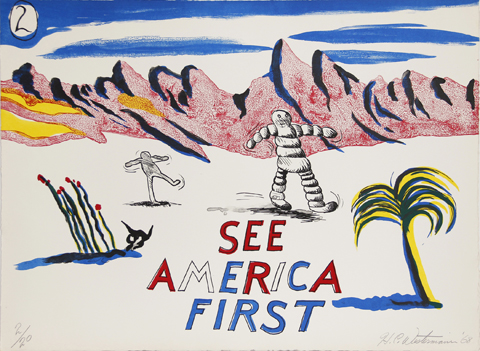
'See America First' (1968), by H.C. Westermann. Collection Beth Rudin DeWoody. Image courtesy Lennon, Weinberg, Inc., New York. © Lester Beall, Jr. Trust/Licensed by VAGA, New York, NY. |
“There used to be an underground and only the right people would find it,” punk cartoonist Gary Panter, who is perhaps best known for designing sets for the 1980s Pee-wee’s Playhouse television show, said in a 2006 talk at RISD. “But now there’s the Internet and everybody finds it. My dad reads it. He’s part of the underground now.”
One of the striking things about the RISD Museum’s new exhibition, “What Nerve! Alternative Figures in American Art, 1960 to the Present” (224 Benefit St, Providence, through January 4), is how even now so much of this astonishing art still remains invisible. It’s not in the history books nor in the museums.
Curators Dan Nadel and Judith Tannenbaum place Panter at the crossroads of their electrifying alternative history of American art over the past half-century, the dude connecting the dots between often overlooked scenes in San Francisco, Chicago, Ann Arbor, and Providence. These artists, Tannenbaum notes, painted people when abstraction reigned supreme, were “counter modern,” and developed regional aesthetics in communities outside the American art market capitals of New York and, later, Los Angeles.
“Definitely the fact they were not in New York is part of whey they weren’t in the narrative,” Nadel says. “But part of it was they were making work that didn’t fit. . . It’s painting, it’s cartooning, it’s surreal, it’s ‘not serious.’ ”
All art school-trained, they rebelled against the fine art world’s notion of a linear progress of apolitical abstraction from Picasso’s Cubism to Pollock’s drip paintings to Donald Judd’s minimalist “primary structures” that mimicked the Western theory of the progress of modern society. Instead the artists here keep mucking around the real world and making ecstatic escapes into fantasy. It’s hot, sweaty, satirical, messy, manic, Technicolor, cartoony, psychedelic stuff that makes the usual museum suspects look horribly square and stiff, pretentious and gray, cold, and boring.
Inventing a new language
On May 14, 1945, H.C. Westermann was an anti-aircraft machine gunner on the USS Enterprise in the Pacific. “We didn’t know it then, but we were shooting the first of the suicide planes,” he later recalled. “It came out of the sun and bore down on us, and we stood there sweating it out until finally our shells tore a wing off. Then the plane swerved at the last minute and went down.”
It struck the stern of the aircraft carrier, killing 14 and bloodying 34 others. Westermann would go on to fight as a Marine in the Korean War, but his experiences of naval battles would inspire a series of uncanny wooden sculptures of ghost ships. He also built miniature houses (1958’s Mysteriously Abandoned New Home) and robot-like faces (1958’s The Evil New War God [S.O.B.]) that feel like magic idols or shrines to an uncanny America.
“He really was a guiding light,” Nadel says, “a model of the independent artist working from the interior, inventing his own language.”
Westermann was part of a lineage of “abject expressionist” art (California curator Michael Duncan’s term) about the horrors of war and the underbelly of society that can be traced back to scathing German Expressionist art created there after the defeat of World War I; to the dark visions of Boston Expressionist painters inspired by those Germans; to Ivan Albright, who returned to Chicago after making medical drawings during the war and began painting hyper-real scenes of people so world-weary that their flesh seems to rot before our eyes.
Westermann was affiliated with a Chicago group called the Monster Roster that included Leon Golub (another veteran) and Nancy Spero. “While Abstract Expressionism rules the cash register in Manhattan’s prospering art galleries, young artists across the land are turning back to images — but with a difference,” Time magazine reported in 1959. “Their figures are human, but horrible. The horror school has its center in Chicago.”
At RISD, we see Westermann’s 1968 series of cartoony lithographs See America First, an acid poke at the old tourism slogan. Inspired by a 1964 road trip to San Francisco that he took three years after moving from Chicago to Connecticut, he scrawls America in flames, Michelin men wandering the desert, a bruised Native American, a cowboy making a pistol with his hand in the bright sunset, ships listing at sea or trapped in ice, zombies having sex. It’s America littered with the wreckage of our self-inflating myths.